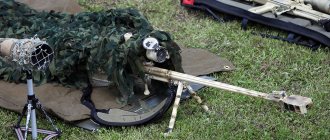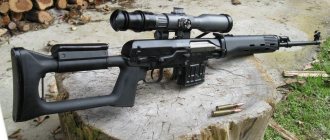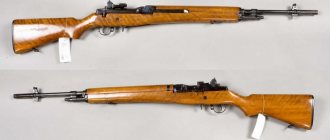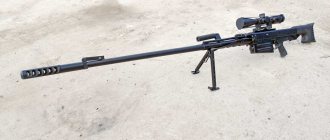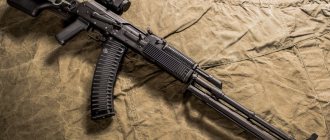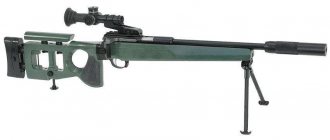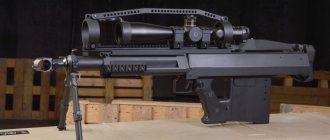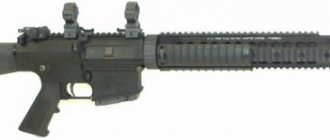ASVK (“large-caliber army sniper rifle”; GRAU Index - 6B7, with optical and night sights - 6S8, 6S8-1) is a Russian large-caliber sniper rifle, created in 2004 by a team of designers at the V. A. Degtyarev plant in Kovrov on based on the KSVK rifles (“Kovrov large-caliber sniper rifle”) and SVN-98 (“Negrulenko sniper rifle”).
ASVK Cord – video
Story
Work on the creation of a large-caliber sniper rifle with a bullpup mechanism layout at the V. A. Degtyarev plant in Kovrov began in 1996. The team of designers working on a fundamentally new type of weapon was headed by Vyacheslav Negrulenko. Just two years later, in 1998, a rifle was created, called SVN-98, which went into the first experimental series. On the basis of the SVN-98, the same team of designers, in 2000, developed the KSVK rifle in the same way as its predecessor, which went into experimental production. After careful testing and experimental operation in the active forces, in 2004, the same authors created an even more advanced rifle, which was called ASVK (“large-caliber army sniper rifle”). It was this type of weapon that, from 2004 to the present, was put into large-scale production.
ASVK Kord-M 6V7M – modernized large-caliber sniper rifle
Adoption
In 2013, the ASVK large-caliber sniper rifle was adopted by the armed forces of the Russian Federation under the name “12.7 mm 6C8 sniper complex.”
ASVK Kord-M 6V7M – modernized large-caliber sniper rifle
Design
Technically, it is a 5-round bolt-action rifle, configured according to a bullpup design (this arrangement made it possible to reduce the total length of the weapon to 1420 mm while maintaining a significant barrel length of 1000 mm).
For firing from ASVK, sniper cartridges of 12.7×108 mm caliber are used; any cartridges of the 12.7×108 mm standard can be used.
When firing, cartridges are supplied from a box magazine. The receiving neck is located between the pistol grip fire control and the butt. The magazine is equipped with a plastic lining that allows it to be used as additional support for the shooter's left hand. Spent cartridges are ejected through a window located on the right side of the receiver, which is closed with a lid in the stowed position.
The “floating” type barrel, fixed cantilever in the receiver and not in contact with other parts of the rifle, is made by cold forging. A muzzle brake is installed on the barrel, reducing recoil force by 2.5 times.
When shooting, a bipod is used, which is attached to a special rod of the receiver. In the stowed position they fold forward.
The butt plate is equipped with a shock absorber made of porous material. This allows the shooter to fire several dozen shots without experiencing discomfort in the shoulder.
ASVK Kord-M 6V7M – modernized large-caliber sniper rifle
Sights
The rifle is equipped with mechanical sighting devices, including a front and rear sight, mounted on a sighting bar, which can also be used as a handle for carrying the rifle. When installing an optical sight, this sighting bar tilts to the right. Standard day optical and night electro-optical sights are used. Optical and night sights are mounted on a special guide mounted on a bracket on the left side of the receiver.
Additional Information
The average dispersion diameter declared by the manufacturer is about 160 mm at a distance of 300 m (without the use of special ammunition). Warranty life, rds. − 3000.
With proper care and cleaning, the barrel can withstand 4-5 thousand shots.
Operating countries
– Vietnam – Russia
Combat use
Used during the Second Chechen War; Used by DPR fighters during the armed conflict in eastern Ukraine.
Development history
Back in the 80s of the last century, many armies around the world began to adopt large-caliber sniper rifles capable of hitting targets at distances of 1 km or more. Such weapons had several important advantages that were appreciated by the military. Firstly, such weapons can effectively hit the enemy at significant distances without exposing military personnel to the danger of being subjected to return fire. Well, secondly, large-caliber sniper rifles are a very effective and inexpensive combat tool for destroying the enemy’s lightly armored equipment and other material objects: radar antennas, anti-tank systems, artillery systems, etc. It’s not for nothing that such rifles are called “anti-material” in the West. .
As mentioned above, work on the creation of a new domestic sniper complex chambered for 12.7 mm began in 1996 at the plant named after. Degtyareva. A whole group of designers led by Vyacheslav Negrulenko worked on this project.
For accurate shooting, the standard 12.7x108 mm machine gun cartridge was not suitable, so at the same time as the rifle, TsNIITochmash began developing a special sniper cartridge.
In 1998, a rifle was created, designated SVN-12.7, which was soon replaced by SVN-98. The weapon went into experimental production.
Unlike most domestic sniper rifles, which, as a rule, were self-loading, the SVN-98 had manual reloading. In addition, the developers used a bullpup layout, which was unusual for weapons of this class. By doing this, they ensured the rifle had minimal dimensions: the length of the weapon was reduced to 1420 mm. The analogues existing at that time with a classical layout had a length of 1700 mm or more. The gain in the weight of the weapon was also significant: for foreign large-caliber rifles it is often 20 or even 30 kg. The weight of the Kord rifle without cartridges and an optical sight is only 12.5 kg.
In fact, the creation of SVN-98 was only the beginning of a rather long story that spanned years. The process of fine-tuning the complex turned out to be extremely difficult and was completed only in 2013. This was affected by the lack of necessary experience among the developers, and all the new requirements put forward by GRAU.
In 1998, the SVN-98 rifle underwent a series of tests, based on the results of which a decision was made to modify the weapon.
In 2000, the same design team presented an already modified version of the weapon, which received a new designation - KSVK. Like its predecessor, the KSVK sniper rifle was put into experimental production.
After testing and modifications in 2004, the rifle received its final form and its fourth name - ASVK, as well as its own name "Kord". Its development continued until 2013, when the complex was put into service and received the GRAU index.
Photo by ASVK Kord
KSVK/ASVK Kord 6V7 - 12.7 mm large-caliber sniper rifle
KSVK/ASVK Kord 6V7 - 12.7 mm large-caliber sniper rifle
KSVK/ASVK Kord 6V7 - 12.7 mm large-caliber sniper rifle
Description of design
The Kord large-caliber sniper rifle is a non-self-loading large-caliber weapon made according to the bullpup layout. The rifle is supplied with ammunition from a detachable box magazine with a capacity of five rounds. ASVK uses 12.7x108 mm cartridges.
The guaranteed service life of the ASVK sniper rifle is 3 thousand shots, but with careful care and regular cleaning, the barrel can withstand 4.5 thousand shots.
The neck for installing the magazine is located between the plastic pistol grip and the butt of the weapon. For ease of holding the weapon, the front part of the magazine is equipped with a special plastic lining. The cartridges are fed into the receiving window by a pusher, which is driven by two flat springs. The cartridge cases are extracted through a window in the receiver, which is located on its right side. When carrying the rifle, it is closed with a lid.
The Kord is a bolt-action rifle. The reloading handle is located in front of the pistol grip. It is quite massive, because with its help you have to move a rather heavy cartridge. When reloading, the handle rotates ninety degrees. The trigger-type rifle trigger allows only single fire.
The rifle has a two-position flag-type safety, which is located on the receiver between the bolt and the neck of the magazine receiver. In the closed (upper) position, it additionally secures the lid covering the window for ejecting cartridges. The trigger guard is sized to allow firing while wearing gloves.
"Kord" has a heavy long barrel: 1000 mm with a total rifle length of 1420 mm. It is cantilever mounted in the receiver and does not touch other structural elements of the weapon (“floating type”). The rifle barrel is made using cold radial forging. It is equipped with a powerful muzzle brake-flash suppressor, which reduces the recoil of the weapon by more than half. Initially, the muzzle brake had a cylindrical shape; during the process of refining the weapon, it changed its shape and design several times. Under the barrel there are folding bipods, which are attached to a special rod of the receiver. When carrying weapons, they fold forward.
On top of the receiver there is a handle for carrying the weapon; it is located near the center of mass of the weapon. In order not to interfere with the installation of optical sighting devices, it is tilted to the right from the central axis of the rifle. To attach sights, a standard rail is used, located on the left side of the receiver.
The butt plate of the butt is covered with a special porous material, which acts as a shock absorber, partially dampening recoil. A shooter can fire several dozen shots from the Kord without experiencing any discomfort in the shoulder.
On the upper part of the receiver there is a special non-adjustable wooden pad - “cheek”.
The rifle has open sights consisting of a rear sight and a front sight; usually the weapon is equipped with a Hyperon optical day sight or a 1PN111 night sight. Although, the standard rail allows the installation of other sights, both domestic and foreign, on a rifle. Initially (on the SVN-98), optical sighting devices were attached to a special bar, which also served as a handle for carrying weapons. But then this decision was abandoned.
7N34 sniper cartridges were developed specifically for Kovrov rifles of 12.7 mm caliber, although this weapon can also use standard 12.7x108 mm ammunition. It is clear that when firing conventional cartridges, the accuracy of the weapon decreases.
A regular B-32 bullet is quite capable of penetrating standard army body armor at a distance of 2 thousand meters, which is the maximum for this rifle. The ASVK sighting range is 1.5 thousand meters.
At distances of up to 1 km, a rifle bullet is capable of hitting lightly armored targets. When firing conventional (not sniper) cartridges, the dispersion diameter is 160 mm at a distance of 300 meters.
In such important indicators as accuracy and accuracy, the large-caliber rifle "Kord" is in no way inferior to its counterparts from Europe, the USA and South Africa. The rifle turned out to be reliable and simple, and reviews of its use in real combat conditions were positive.
The Kord rifle is a production weapon. It can be supplied to units as part of two sniper complexes. The first, in addition to the 6V7 rifle itself, includes a 1P71 optical sight and a 1PN111 night sight, as well as a 7N34 cartridge. The GRAU index of this complex is 6С8. The second one is lightweight and does not include a night sight. Its index is 6С8−1.
Sniper rifles
ASVK / KSVK. Large-caliber sniper rifle. (Russia)
ASVK / KSVK (Army / Kovrov Sniper Rifle Large-caliber) is a Russian large-caliber sniper rifle. Officially adopted by the Russian Armed Forces in June 2013.
The 12.7 mm sniper complex ASVK / KSVK / 6S8 is designed for fire destruction of unarmored and lightly armored enemy vehicles, elements of strategically and tactically important infrastructure / objects, group and single targets, as well as openly located enemy manpower protected by NIB at ranges of up to 1500 meters.
ASVK / KSVK. Large-caliber sniper rifle. (Russia)
In 1997, a group of designers from the V.A. Plant. Degtyarev, which is located in the city of Kovrov, Vladimir region. (now OJSC ZiD), under the leadership of V. I. Negrulenko, the development of a large-caliber sniper rifle for the security services and army of the Russian Federation began.
In 1998, the work was completed, an experimental version of the rifle under the name SVN-12.7 (Negrulenko Sniper Rifle, later it was renamed SVN-98, and KORD - the rifle designation code at the development stage) was presented to representatives of interested government agencies .
At the same time, several samples of weapons were manufactured, which subsequently passed all the necessary tests, including in the combat conditions of the second Chechen War by soldiers of the GRU General Staff and the FSB of the Russian Federation. Based on the results of the tests, several shortcomings of the weapon were identified, and first of all, a very powerful recoil, which negatively affected not only the accuracy/accuracy of shooting, but also discouraged the shooter from continuing to fire from the rifle due to extensive bruises and nicks on the shoulder. The weapon clearly needed improvement.
ASVK / KSVK. Large-caliber sniper rifle. (Russia)
As a result of this, already in 2000, a prototype of a modernized rifle was presented under the name KSVK (Kovrov Large-Caliber Sniper Rifle), which had improved characteristics and technological solutions in the form of a muzzle brake-compensator of a different shape and an improved butt plate lining, which reduced the level of recoil in 2 times.
In 2004, the final version of the rifle was presented - ASVK (Army Large-Caliber Sniper Rifle), which, however, was not officially adopted by any security forces, but was unofficially used in combat special operations by individual security and army structures.
ASVK / KSVK. Large-caliber sniper rifle. (Russia)
Characteristics:
- Weight, kg: 12.5 (without cartridges and optical sight);
- Length, mm: 1420;
- Barrel length, mm: 1000;
- Cartridge: 12.7×108 mm;
- Caliber, mm: 12.7;
- Operating principles: longitudinally sliding gate;
- Rate of fire, rounds/min: 10;
- Initial bullet speed, m/s: 900;
- Sighting range, m: 1500;
- Type of ammunition: box magazine for 5 rounds;
- Sight: open, there is a rail for attaching an optical sight.
